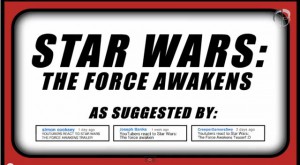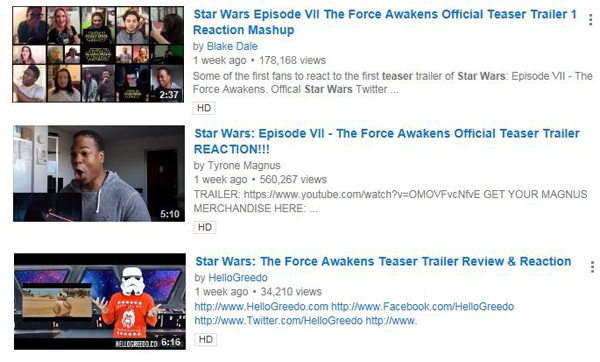Star Wars Now: Fan Creativity and That Trailer
 Has there ever been so much kerfuffle around 88 seconds? Granted, Star Wars fans have often (stereotypically) been viewed as fanatical about the fan object, a fanaticism that borders on obsession and is often understood as a impassioned, psychologically questionable pursuit of a force-platonic ideal of textual authenticity.
Has there ever been so much kerfuffle around 88 seconds? Granted, Star Wars fans have often (stereotypically) been viewed as fanatical about the fan object, a fanaticism that borders on obsession and is often understood as a impassioned, psychologically questionable pursuit of a force-platonic ideal of textual authenticity.
I am not sure if I have ever bore witness to such a flurry of fan activity and creativity within such a short period of time. Given that the trailer debuted just over two weeks ago (although I am writing this after merely seven days), it astonishes me how quickly ‘24-7 always on’ digital fandom reacted and began posting comments, videos, parodies and artwork to continue constructing the Star Wars: The Force Awakens (or Episode VII) text twelve months before its December 2015 release.
I am currently working on a book-length study of the latest phase in Star Wars history. Tentatively titled, A New Hope?: Digital Fandom and the Star Wars Renaissance, I have been tracking how paratexts—whether producer- or viewer-generated—discursively surround the Star Wars text and how this interplay between audience and industry generates meaning and value creation. I began the first part of this project in 2012 when I conducted an audience research project to gauge fan reactions to the sale of Lucasfilm to Disney.
 During the research process, I discovered that for many fans the Force Awakens text had already begun despite the fact that, at the time, there were no plans for the Star Wars Saga to continue in film (“officially,” at least). As Henry Jenkins pointed out in the seminal Convergence Culture, fans were “determined to remake it on their own terms.” More than this, however, fans were determined to “continue” the saga as well as “remake” it. Now that the sale of Lucasfilm to Disney has opened up the ostensibly “closed” text for further adventures, how will fans continue to play with the Star Wars brand within participatory culture?
During the research process, I discovered that for many fans the Force Awakens text had already begun despite the fact that, at the time, there were no plans for the Star Wars Saga to continue in film (“officially,” at least). As Henry Jenkins pointed out in the seminal Convergence Culture, fans were “determined to remake it on their own terms.” More than this, however, fans were determined to “continue” the saga as well as “remake” it. Now that the sale of Lucasfilm to Disney has opened up the ostensibly “closed” text for further adventures, how will fans continue to play with the Star Wars brand within participatory culture?
Within hours of the trailer’s release, fan vids and art began to surface in cyberspace. Live reactions were filmed and uploaded to YouTube: some of these were intensely emotional, while others were fan parodies of fan reactions (usually of those who visibly wept), and others were negative or indifferent (like the Amazing Atheist who maintained that caution was the best approach citing the Prequel Trilogy as evidence of how things could go horribly wrong). ZachFB Studios uploaded a home-made version of the trailer as homage created entirely with LEGO, and numerous others followed suit.
 There were many criticisms of the new lightsaber with its cross-guard judged by many to be ‘unrealistic’ and lacking sufficient rationale—in his own breakdown on The Colbert Report, Stephen Colbert pointed out one fan who tweeted “hilt on lightsaber stupid and impractical childhood ruined everything ruined!!!1!”
There were many criticisms of the new lightsaber with its cross-guard judged by many to be ‘unrealistic’ and lacking sufficient rationale—in his own breakdown on The Colbert Report, Stephen Colbert pointed out one fan who tweeted “hilt on lightsaber stupid and impractical childhood ruined everything ruined!!!1!”
Fan art – once again, within hours — was uploaded via Instagram and Tumblr with links provided on Twitter and Facebook.
 As Jonathan Gray and Jason Mittell have previously argued about fans of Lost, “spoilers” are often actively sought out as an integral feature of the fan experience. Lucasfilm carefully control the release of snippets of information to orchestrate a viral campaign that seeks to stimulate awareness of the brand to create a fever pitch as lead-up to the actual release of the film. Whether or not photographs of the Millennium Falcon or other concept images were “leaked” by Lucasfilm or via other methods—such as Latino Review reporting that set photographs were stolen by a Rebel Alliance of fans who used “affordable home drone technology” to swoop over locations and provide the world with snapshots of X-Wings and so forth—is difficult to determine. After all, this could be part of the plan to drip-feed the audience with tantalising teasers to turn us into Star Wars junkies all over again. Conversely, as Matt Hills suggests in a study of Sherlock spoilers, part of the attraction for forensic fandom is to assuage ontological anxieties about the fan-object, especially when the “idealized object is potentially threatened” by seeking out spoilers to mediate and monitor whether that which is being created matches up with a platonic textual authenticity. For many fans, the idealized object is, indeed, “threatened” (read: prequels) and this—to quote Hills—”working through of possible threats” is negotiated by paratextual exegesis and excursions into spoiler territory.
As Jonathan Gray and Jason Mittell have previously argued about fans of Lost, “spoilers” are often actively sought out as an integral feature of the fan experience. Lucasfilm carefully control the release of snippets of information to orchestrate a viral campaign that seeks to stimulate awareness of the brand to create a fever pitch as lead-up to the actual release of the film. Whether or not photographs of the Millennium Falcon or other concept images were “leaked” by Lucasfilm or via other methods—such as Latino Review reporting that set photographs were stolen by a Rebel Alliance of fans who used “affordable home drone technology” to swoop over locations and provide the world with snapshots of X-Wings and so forth—is difficult to determine. After all, this could be part of the plan to drip-feed the audience with tantalising teasers to turn us into Star Wars junkies all over again. Conversely, as Matt Hills suggests in a study of Sherlock spoilers, part of the attraction for forensic fandom is to assuage ontological anxieties about the fan-object, especially when the “idealized object is potentially threatened” by seeking out spoilers to mediate and monitor whether that which is being created matches up with a platonic textual authenticity. For many fans, the idealized object is, indeed, “threatened” (read: prequels) and this—to quote Hills—”working through of possible threats” is negotiated by paratextual exegesis and excursions into spoiler territory.
In the week following the trailer’s release, the mysterious figure know only by the nom de guerre “Spoilerman” leaked alleged, crucial plot details about The Force Awakens (which I could not help but read—I blame research, as despite being someone who usually avoids spoilers of any kind, I found that I could not help myself!). Once more, whether or not this clandestine “Spoilerman” is anything but a Lucasfilm/Abrams plant is difficult to ascertain; however, within the so-called spoiler itself, we are told that “fake” paratexts will be leaked periodically to misdirect and confound the sniffer dog-fans so that no one can be entirely sure what is real and what is not, suggesting there may be something rotten within Spoilerman’s “spoiler” itself.
As a researcher, the rich and creative fandom discursively surrounding a text that does-not-quite-exist yet—although Gray would no doubt argue that this is all part of the text—provides a mélange of data. Methodologically, however, worms are crawling everywhere. This is what I am thinking through at the moment as I seek to conduct an audience research project that is rather ambitious by looking at what Paul Booth has described as “transgenic media.” Instead of focusing on one platform, I want to bring in examples from Twitter, Facebook, Youtube, Instagram, and so on, while also speaking directly to fans leading up to, and including, the release of Star Wars: The Force Awakens.
This much is certain: Episode VII is in full swing, and we’ve only seen 88 seconds of footage.



